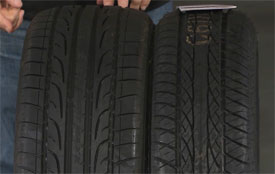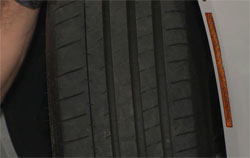Tire Rotation Update
Recently I did a segment on tire rotation. And I got a lot of comments on it. We were dealing with conventional tires, and a lot of you said that my method of rotating the tires that go on the drive wheels from one side of the car to the other, that that was completely wrong. Well, I stand by that because, it’s not my idea; that comes from information supplied by various tire manufacturers. Here’s the diagram in this book from Firestone. So, that’s the way it works.
 But, what we didn’t talk about in that segment was tires that were designed like this one; this is a directional tire. We can see that the tread works in one direction only. It actually has an arrow on the sidewall that tells you the direction that that tire has to turn in. Well that means that if we mount this tire so that it goes on the right side of the car, it must always stay on the right side of the car. And that means that you can’t do a proper tire rotation. Now to take that further, if you have to have different size tires on the front and rear, you can’t even swap them from front to rear. And that ultimately means that you may wind up with tires that are very, very noisy long before they’re worn out.
But, what we didn’t talk about in that segment was tires that were designed like this one; this is a directional tire. We can see that the tread works in one direction only. It actually has an arrow on the sidewall that tells you the direction that that tire has to turn in. Well that means that if we mount this tire so that it goes on the right side of the car, it must always stay on the right side of the car. And that means that you can’t do a proper tire rotation. Now to take that further, if you have to have different size tires on the front and rear, you can’t even swap them from front to rear. And that ultimately means that you may wind up with tires that are very, very noisy long before they’re worn out.
 Now we’re seeing a gradual move away from directional tires. This BMW has a new style of tire on it, that we’re seeing more and more of. This is asymmetrical, non-directional. Now, asymmetrical because the tread on the inside is different than the tread on the outside. And it is non-directional because it can go on either side of the car; it can turn it either direction. Now, the way you can tell the difference: you have the directional arrow on the tire that always has to turn in one direction only. Here, we have “outside” stamped into the outside of the tire, and “inside” on the other.
Now we’re seeing a gradual move away from directional tires. This BMW has a new style of tire on it, that we’re seeing more and more of. This is asymmetrical, non-directional. Now, asymmetrical because the tread on the inside is different than the tread on the outside. And it is non-directional because it can go on either side of the car; it can turn it either direction. Now, the way you can tell the difference: you have the directional arrow on the tire that always has to turn in one direction only. Here, we have “outside” stamped into the outside of the tire, and “inside” on the other.
Now on these tires, you can swap them from one side to the other; if all four tires are the same, you can do the modified “X”, where you cross the two tires that go onto the drive wheels. But, if they’re different size front to rear, you simply go right to left, left to right, on the front and then on the rear. It means that these tires can get a lot more miles out of them, and they can stay quiet for a very long time. And if you have a question or comment, drop me a line. Right here, at MotorWeek.





